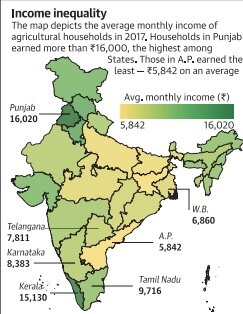
Income Inequality Among Farmers | 08 Jul 2019
- A recent survey conducted by NABARD, highlights the high levels of inter-state income inequality among the agricultural household in India.
- The data given in the survey depicts that inter-state income inequality among agricultural household range from Rs 16,020 (In Punjab: highest) to Rs 5,842 (In Andhra Pradesh: lowest).

- Adding more to the grim picture of agricultural distress, the surplus remains after consumption expenditure is just Rs 95 in Andhra Pradesh and Rs 4,314 In Punjab.
- Also, according to the survey, 85% of farmer households earn a mere 9% of the total income, while the top 15% earn 91%.
- If it is compared with the overall inequality in India, it’s far too high.
- Given the stark inequality in India, it shouldn't come as a surprise when the report says that 43 per cent of India’s indebted households is farm households.
- This aspect is important in the context of the government’s target of doubling farmers’ income.
- Land possession was the key variable in determining income from cultivation, which accounted for half of the income inequality and hence was the key variable in explaining income inequality.
- The lowest among the farmer groups in terms of landholding earns the least.
- India primarily consists of small and marginal farmers(Farmers whose land holdings are less than two hectares (Ha) of land. About 85% landholdings in India are below two Ha)
- So this makes small farmers take longer to increase their income in comparison to large farmers.
- According to Ashok Dalwai committee doubling farmers’ income by 2022: The initial promise of agrarian reforms was to distribute land to the landless and provide the title of ownership to the cultivators.
- Unfortunately, India’s agrarian reforms did not ensure egalitarianism in the agricultural community.
- The Green Revolution in the 1960s focused on increasing productivity and yield. But since then, landholdings have become significantly fragmented. Marginal landholdings have tripled in the last 40 years.

